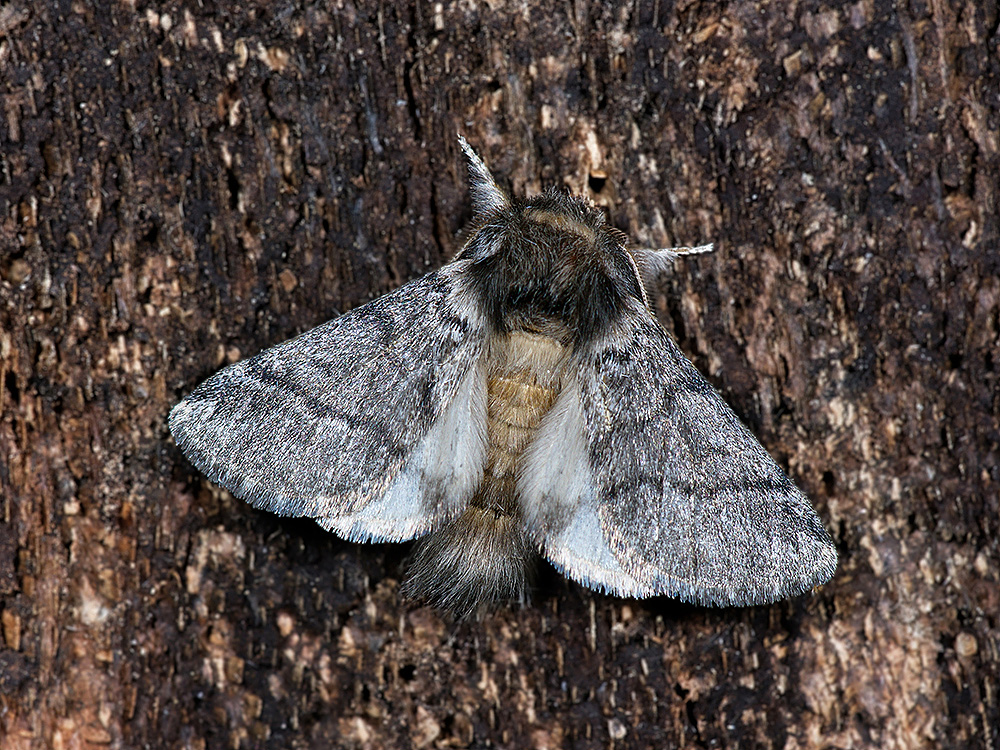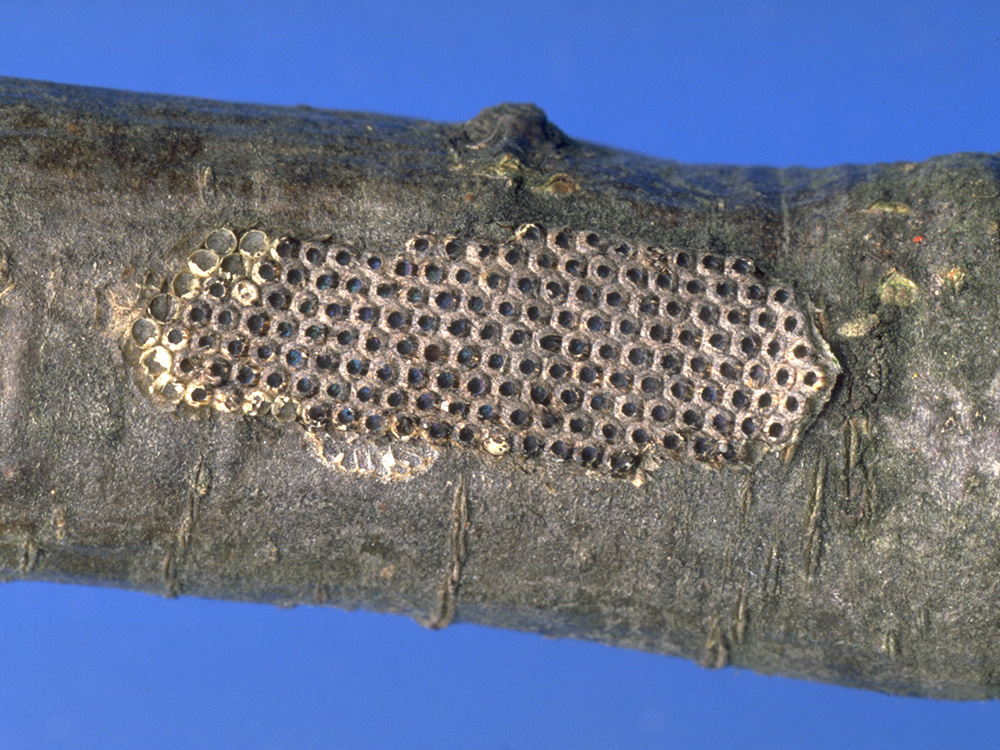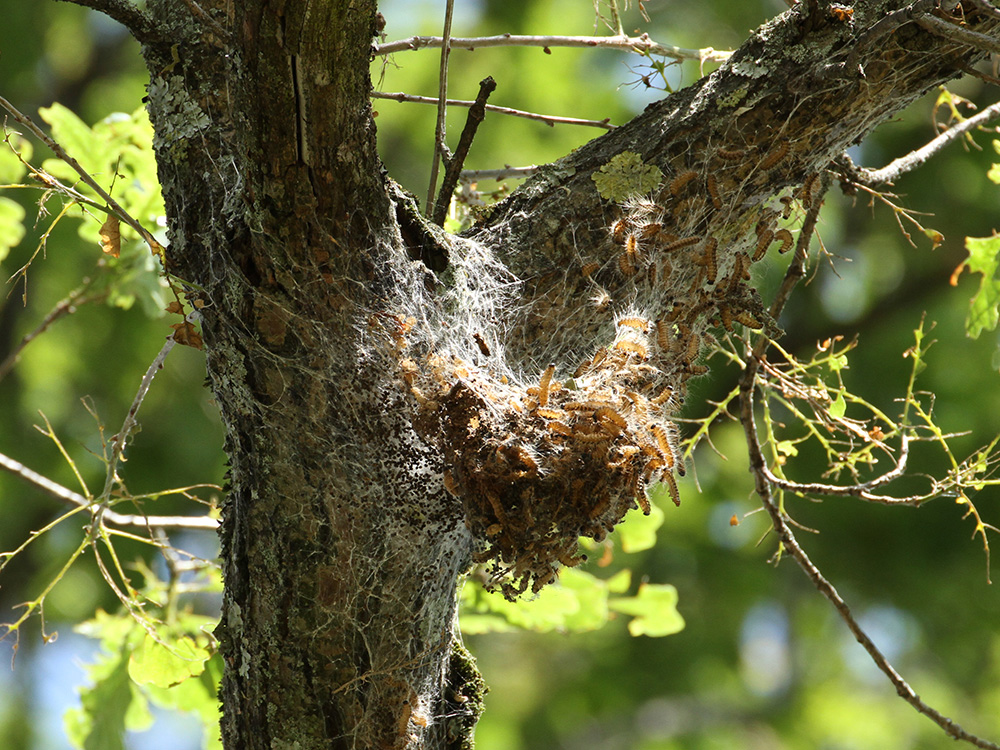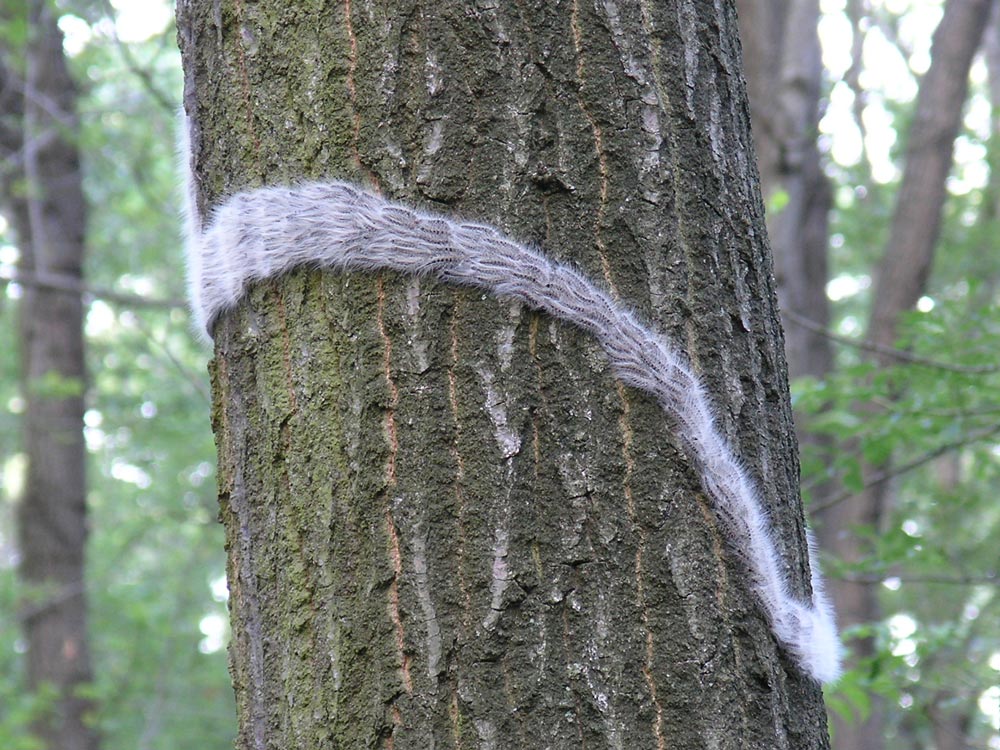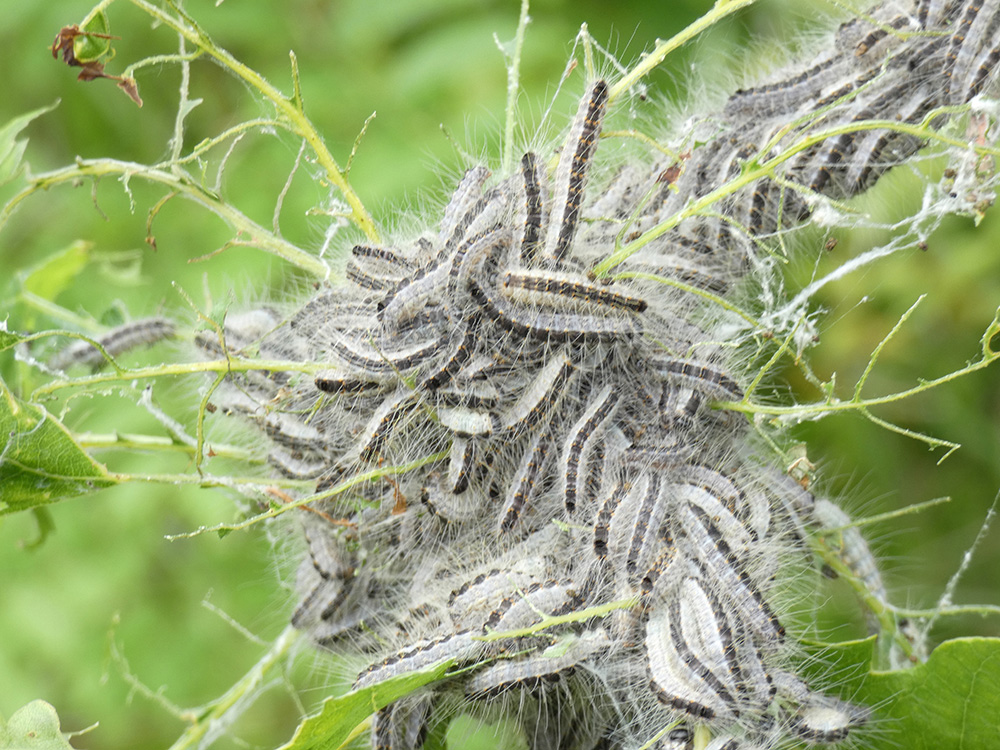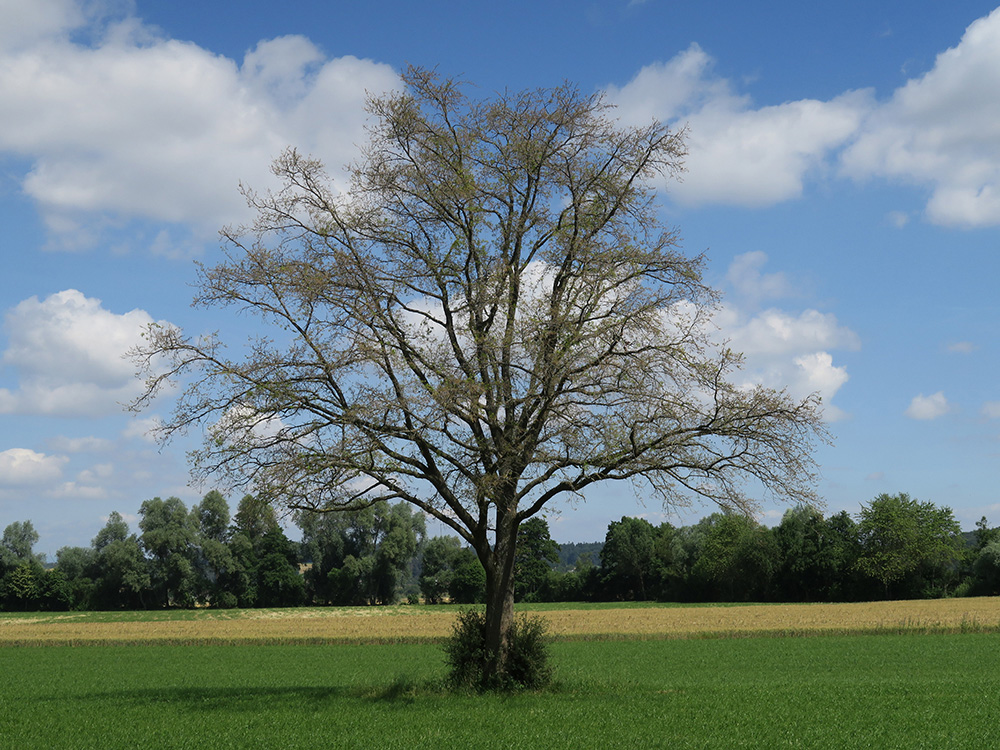Range and means of dispersal
The range of the oak processionary moth (Thaumetopoea processionea [L.]) extends across southern and central Europe, from the Black Sea to the Iberian Peninsula. In 2006, this moth species was also detected for the first time in the UK, where it was probably introduced accidentally on imported plants and plant products. In Switzerland, occurrences of the oak processionary moth are currently focused mainly in a few small areas of infestation in western and north-western Switzerland, and on the southern side of the Alps. Other isolated cases have been reported from the Central Plateau, the Zurich area, and north-eastern Switzerland (fig. 1).
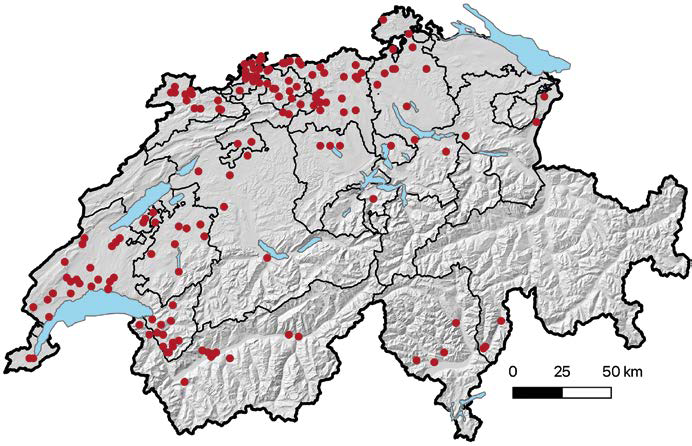
Fig. 1. Map of the distribution of the oak processionary moth in Switzerland, based on confirmed reporting data of Swiss Forest Protection Group from 1988-2020. Geobasis data: Federal Office of Topography swisstopo.
In Central Europe, there has been an increase in both the frequency and intensity of occurrences of the oak processionary moth over the last four decades. The oak processionary moth spreads both naturally and through accidental introduction as a result of human activities. The most significant anthropogenic cause of the spread of T. processionea is considered to be the trade in young oak plants, on which it is easy to overlook any egg masses, caterpillars, or pupae. Another possible pathway for its spread is the transport of oak roundwood with bark present from oak processionary moth infestation areas.
Biology
Mass propagation
Under favourable climatic conditions and given a sufficient supply of host plants, the oak processionary moth tends to mass propagate (gradation). This can involve a gradation cycle lasting up to ten years, which ultimately ends in a collapse of the population. However, the mechanisms of these population dynamics are not yet understood in detail. The population collapse is thought to be caused by an interplay of climate factors, resource limitations, and the development of populations of natural enemies in sufficiently high numbers.
Natural predators
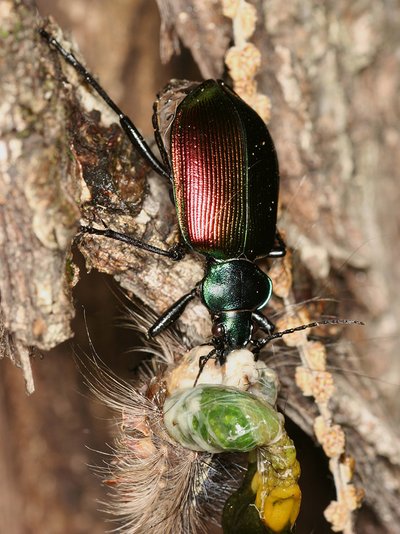
Fig. 8. A forest caterpillar hunter (Calosoma sycophanta) feeding on a butterfly caterpillar. Photo: Beat Wermelinger
Processionary moth species are well protected against natural predators at all stages of development. The eggs are protected by hairs from the mother animal. The caterpillars retreat into densely woven nests during the day, and from the third instar onwards, the larva produces urticulating hairs. The adult moths are also well camouflaged. Natural predators have nevertheless been identified for all developmental stages of processionary moths, although there is little data available on this specifically for the oak processionary moth. Studies have shown that the egg plaques can be parasitised by chalcid wasps such as Anastatus bifasciatus. Parasitoid caterpillar flies such as Carcelia iliaca or Pales processioneae, and some Braconidae and ichneumon wasps are considered to be natural predators of the caterpillars and pupae. The two pupal predators Calosoma sycophanta (fig. 8) and C. inquisitor are among the most significant predators of the caterpillars and pupae. Generalists such as spiders or ants also prey on the caterpillars of oak processionary moths. Among vertebrates, bats are known to be natural enemies, as well as birds, including the cuckoo (Cuculus canorus) and tits, for example. Pathogenic microorganisms associated with the oak processionary moth are the bacterium Bacillus thuringiensis, various microsporidian species and a virus. However, their impact on the population dynamics of the insects is still largely unknown.
Health hazards
From the third instar (around the end of May), the caterpillars begin to develop thousands of these tiny stinging hairs as a defence. Even with little pressure, they break off and are easily shed, especially towards the end of moulting phases. Since stinging hairs are also present in the exuviae, the nests contain large concentrations of them. The stinging hairs can also be blown about by the wind.
Contact with the stinging hairs can cause allergic reactions to the eyes, skin and upper respiratory tract in humans and animals (fig. 9). In rare cases, contact with the stinging hairs of T. processionea can lead to allergic shock.
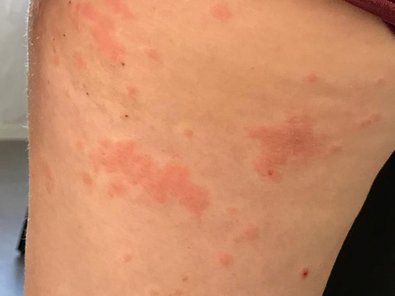
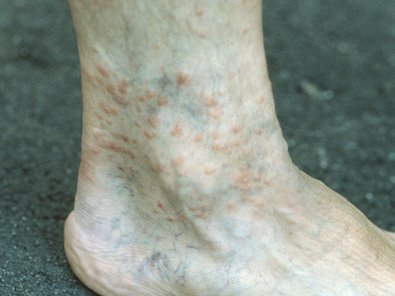
Fig. 9. Allergic skin reactions caused by the stinging hairs of the oak processionary moth.
The stinging hairs can remain toxic over several years. Old nests of processionary moths are therefore also a particular hazard. In the vicinity of infested oaks, the stinging hairs can also accumulate over several years in the ground vegetation and undergrowth, and cause allergic reactions after contact with clothing and shoes.
Processionary moth caterpillars, their nests and accumulations of stinging hairs are thus an ongoing health hazard during management operations and recreational activities in forests.
What to do if someone has allergic symptoms?
If allergic symptoms occur after contact with the stinging hairs of the oak processionary moth, aha! Allergy Centre Switzerland advises you to contact your general practitioner or an allergy specialist.
www.aha.ch
aha!infoline: +41 31 359 90 50
Dealing with oak processionary moths
Since infested oaks are not usually discovered in the forest, but in gardens, agricultural areas, cemeteries, school playgrounds or on other public land, decisions on potential countermeasures are often not within the competence of the forest protection officers. According to the statements of several forest protection officers, however, there are not fewer infestations in the forest than in urban areas. They are however less noticeable, as the nests are often only noticed when the first allergic reactions in people occur. Due to the lower footfall and shorter time spent in the vicinity of trees in the forest, this is less often the case in forests than in settled areas.
In Swiss forests, the risk to health posed by oak processionary moth infestations can usually be minimised by restricting access to trees or paths, and by systematically implementing measures to raise awareness among the population. Only in rare cases, such as on forest edges where mowing is required, is T. processionea actively treated. The use of environmentally hazardous substances is generally prohibited in the Swiss forest. In exceptional cases, agents approved by the canton’s authorities for the oak processionary moth and specifically for the forest may be applied.
Recommended action
No measures are currently necessary to protect the forest and timber production from this pest in Switzerland. In the event of any infestation, the question generally arises as to whether the risk posed by the caterpillars is acceptable from a health point of view. Especially in places with a high footfall, counter-measures must be considered, taking the local circumstances into account. As well as raising public awareness by erecting information boards and by cordoning off sections of path, measures may include the removal of the nests by specialist arborist companies or public services (forestry service, fire brigade).
In northern Germany, the situation is different. The widespread occurrence of the oak processionary moth has become a serious problem there, sometimes infesting entire sections of forest. Control measures are therefore often also carried out on a large scale, using insecticides applied using helicopters or trucks. Alternatively, positive experiences have been made in Germany with the targeted application of a water-based sugar solution as a fixative in dealing with the oak processionary. This sugar solution traps both the caterpillars and the stinging hairs directly in the webbing of the nests, and forms a solid, glass-like structure once it has dried. Since the stinging hairs are no longer a danger and the product is biodegradable, the treated nests do not have to be removed.
Literature
Literature references can be found in the original publication (PDF).
You can order the printed WSL fact sheet The Oak Processionary Moth. Background knowledge and recommended action free of charge from WSL:
WSL e-shop
Zürcherstrasse 111
CH-8903 Birmensdorf
e-shop@wsl.ch

